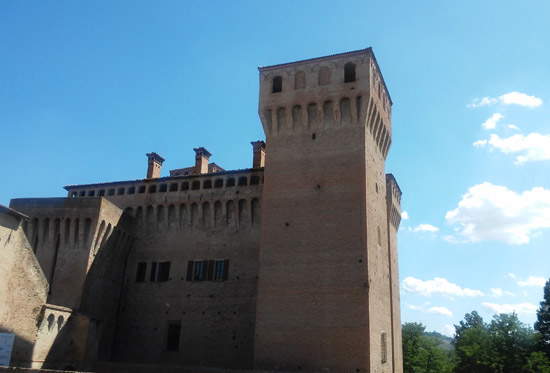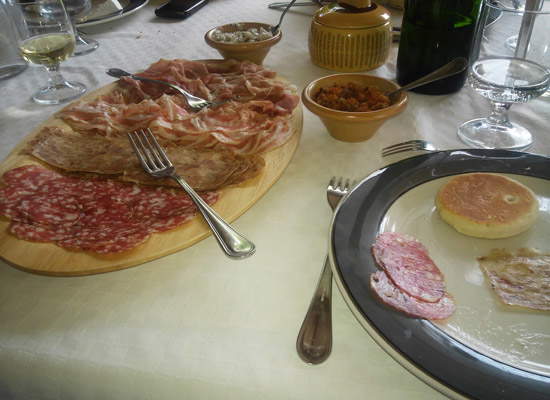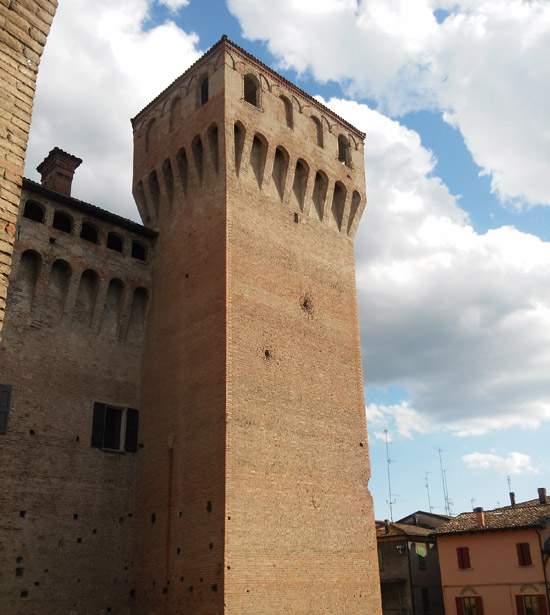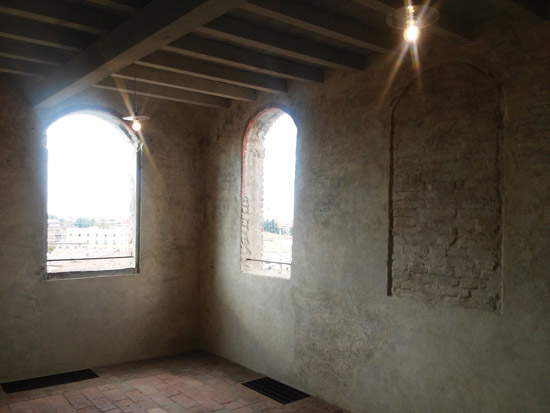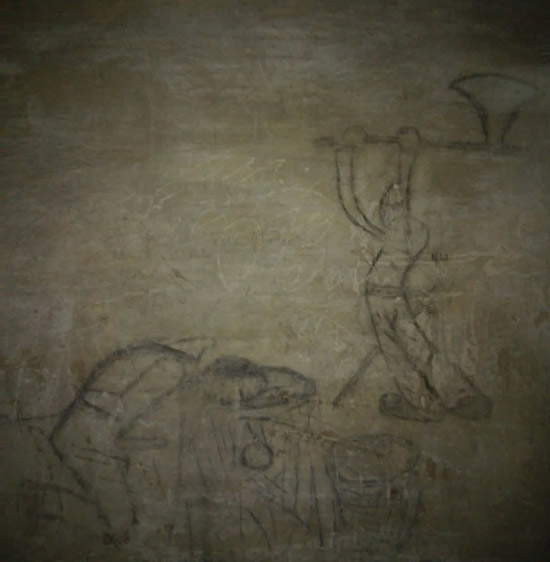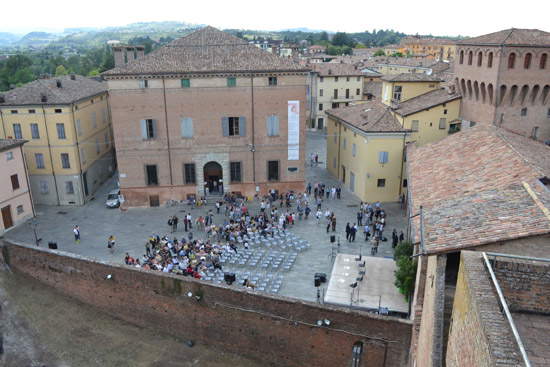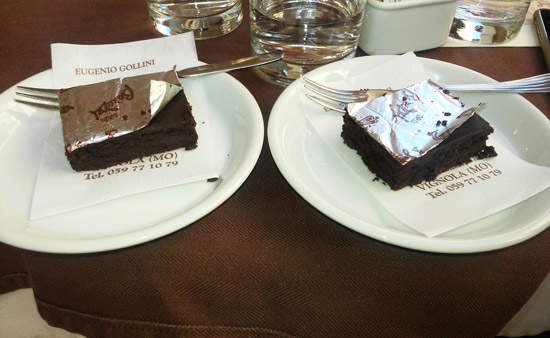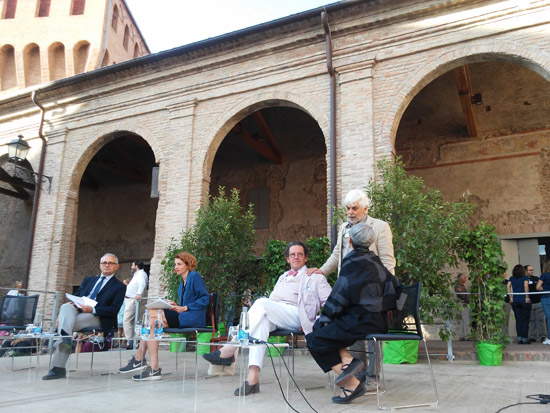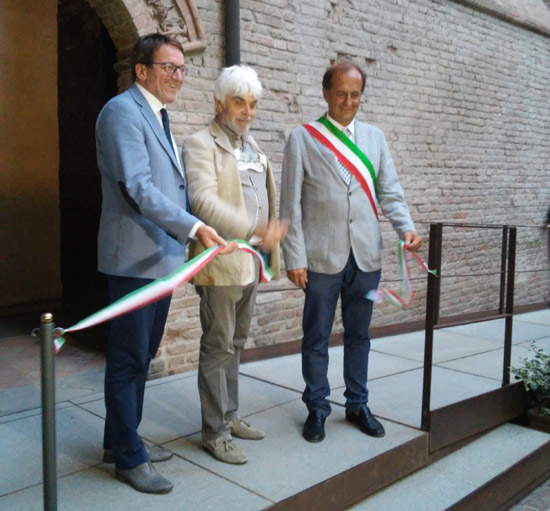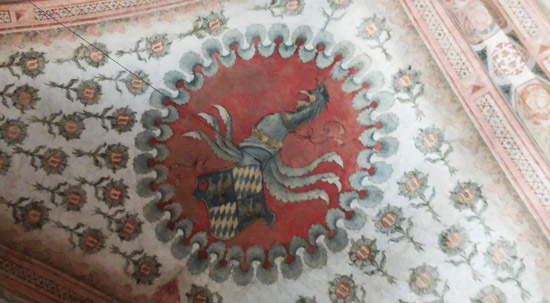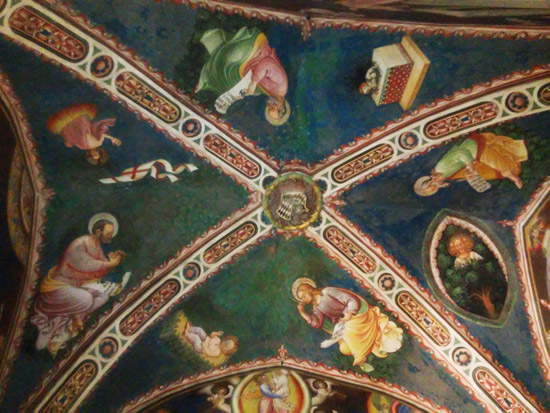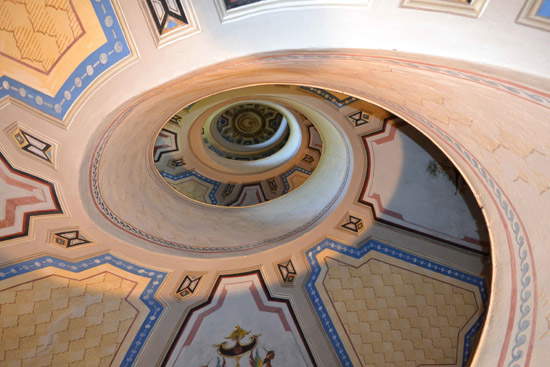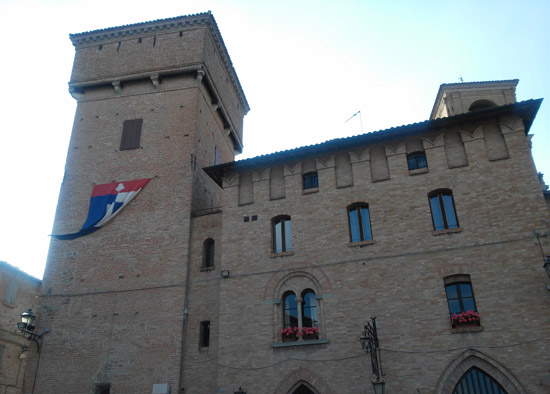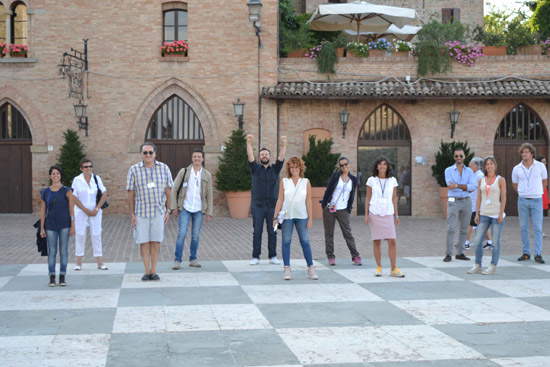by Federico Giannini (Instagram: @federicogiannini1), published on 08/09/2015
Categories: Travel
/ Disclaimer
The reportage of the #tracceinluce tour, which took us to discover Vignola, its Rocca and its surroundings.
An ancient tower that reopens after careful restoration, 15th-century frescoes that come to life in the form of a video projection on the walls of the Fortress of Vignola fortress, an exhibition documenting years of studies divulging them to the general public, idyllic landscapes among cypress trees and castles, villages where time seems to have stood still, and a robust but very tasty cuisine: these are all the ingredients of #tracceinluce, the tour that, this weekend, took a group of bloggers and art and travel journalists, among the most followed in the country, to discover Vignola and its surroundings. All as part of the Traces in Light project, the exhibition that aims to present to the public the studies that enabled the restoration of the Brush Tower and the re-enactment of the frescoes that decorated the exterior of the Rocca. This time Finestre Sull’Arte is fifty-fifty: at the time of Emilia, only I, Federico, am leaving, and Ilaria is staying at the base... !
 |
| The Fortress of Vignola |
I arrive in Vignola on time, after an uneventful journey: I catch up with the group and together we take advantage of a stop at Caffé Terzi, which offers a rich coffee menu declined in numerous (and tasty) variations, for a cheerful exchange of pleasantries and the presentation of the day’s program. A program that begins right in the center of Vignola: the first stop is theAcetaia Comunale, housed in the 18th-century Villa Tosi-Bellucci, the work of a local architect, Giuseppe Maria Soli, and built during the 1910s. This building, which reflects the neoclassical taste of the time, was given by the Tosi-Bellucci family in 1915 to the Municipality of Vignola, which in 1998 made it the site of the first vinegar cellar a municipality has ever endowed itself with: the purpose of the institution is to preserve, hand down and spread the culture oftraditional balsamic vinegar. A number of batteries, or sets of barrels in which the vinegar is aged, spread the strong scent of this gastronomic treasure that characterizes Modena and its province through the halls.
 |
| Villa Tosi-Bellucci, home of the Acetaia Comunale di Vignola (Vignola Municipal Vinegar Works). |
 |
| A battery |
 |
| The end result: a small bottle of traditional balsamic vinegar of Modena DOP |
Tasting the traditional balsamic vinegar whets the appetite, and after a lunch of tortelli, gramigna with sausage and especially tigelle stuffed with typical cured meats, jams and various sauces, we head back to Vignola for an exclusive preview visit to the newly reopened after restoration Torre del Pennello. Built in the early fifteenth century as part of the expansion of the Fortress of Vignola fortress ordered by the local feudal lord, Uguccione Contrari, the Tower rises thirty-two and a half meters and is so called because a garitta, the small building that served for sightings, stands out on its summit: since the garitta is also called a “brush,” it is easy to understand where the Tower’s name comes from. The crenellated floor, formerly used to house the fortress guards, in the 19th century became the apartment of the keeper of the prisons that were set up in the fortress. The life of the keeper was not supposed to be easy, but certainly even less easy was the life of the prisoners: on the lower floor, we can visit the so-called “Cimino prison,” so called because in 1809 the brigand Cimino, author of the curious graffiti we see on the walls, recovered during the restoration, was imprisoned there: it is a sort of summary of his life, which ends with the macabre vision of what will be his end. Before going down, one last tour of the patrol walkways for a few photos of the wonderful view from the Tower.
 |
| Tigelle and cold cuts! |
 |
| The Brush Tower |
 |
| Panorama of Vignola from the Torre del Pennello |
 |
| One of the rooms of the janitor’s dwelling |
 |
| An eerie graffito by the brigand Cimino |
 |
| Surviving 15th-century writings on one of the Tower’s walls |
The Piazza Contrari, on which the Rocca stands, is beginning to fill with people, because in the late afternoon, before the opening of the exhibition and the Tower, a meeting-debate is scheduled with Philippe Daverio, Valerio Massimo Manfredi, Marco Carminati, Natalia Gurgone (the curator of the Tracce in luce project) and architect Carla Di Francesco of the Ministry. Before the meeting, however, it is necessary to stop for a moment at the Gollini pastry shop, which produces the famous Torta Barozzi, a chocolate delight whose recipe is secretly preserved by the descendants of Eugenio Gollini, the man who invented this dessert in the late 19th century. After the mouth-watering stop, we return to Contrari Square to attend the conference. Important topics are touched upon, all centered on restoration. For Carla Di Francesco, the discipline of restoration is constantly evolving, going hand in hand with scientific research and technological innovation. For Natalia Gurgone, a restoration project should combine scientific seriousness and disclosure, with full respect for the buildings. Philippe Daverio notes that, despite the fact that the reception and transmission of the past have entered a crisis, and with them also the opinion of experts, it is difficult to ask how far a restoration can go, but it is great if a restoration succeeds in evoking history in all its passages. The conclusion of the discussion falls to Valerio Massimo Manfredi, who observes how our country is full of wonders that should be loved and respected-a somewhat mannered closing, but one that nonetheless makes a great impression on the audience. It is then time for the official opening: after the authorities’ greeting, with a beautiful tribute to Khaled Asaad, the ribbon is finally cut. Visits to the exhibition can begin!
 |
| Contrari Square begins to fill up... |
 |
| The Barozzi Cake |
 |
| The debate with, from left, Marco Carminati, Natalia Gurgone, Philippe Daverio, Valerio Massimo Manfredi, Carla Di Francesco |
 |
| The ribbon cutting with Valerio Massimo Manfredi and the authorities |
Evening falls, and we enter the rooms of the Rocca precisely to visit the exhibition. At the basis of the project, a precise goal: “to save the memory of a splendid colorful scenery, and of the refined culture that conceived it.” Room after room, we look at the high-definition images of the fragments of the 15th-century frescoes, the photographs of the documentation campaign, the watercolors of the artists who also brought the exterior decorations of the Rocca to life in painting, the accurate descriptions of the individual architectural elements of the tower, and the plans for the show scheduled for the opening night: video projections of the 15th-century frescoes on the walls of the Rocca. Hundreds of people, in Contrari Square, watched in silent fascination as the show took everyone back six hundred years.
 |
| Traces in light, the exhibition: a watercolor shows us what the Rocca looked like in the 15th century |
 |
| Traces in light, the exhibition: images from the photographic campaign on the fragments of the 15th-century frescoes |
 |
| The ancient frescoes come to life at night, in a video projection show |
The next morning we leave our lodging, the B&B Ca’ dei Sogni in Levizzano Rangone, and set off for Vignola, for an in-depth visit to the Rocca in the company of Achille Lodovisi, director of the Documentation Center of the Fortress of Vignola Foundation. Behind every fresco is a symbol, behind every wall a story. Fascinating is that of the Contrari Chapel, where a 15th-century pictorial cycle is preserved in an excellent state of preservation: we will tell you about it in a dedicated post. Amid marriage allegories, feats of lions and cheetahs, coats of arms of lords and ladies, hidden caricatures, refined witticisms of artists and Renaissance dreams, the great expertise of Achille Ludovisi, a refined and engaging guide who knows every nook and cranny of the Fortress of Vignola, is revealed. It is impossible to account for everything in a summary post, because we could talk about the Rocca for hours on end. Let us, for now, let pictures replace words, but rest assured: as mentioned, we will come back to tell you about the Rocca!
 |
| The feat of the pardo |
 |
| The coat of arms of the Contrari |
 |
| Bizarre caricatures hidden in the marbling |
 |
| The vault of the chapel |
Before lunch, a visit to one of the symbols of Vignola awaits us: the Contrari-Boncompagni Palace. It is famous because it houses one of the most spectacular works by Jacopo Barozzi, known as the Vignola (1507 - 1573), one of the most modern architects of the 16th century: the famous spiral staircase. It is a riot of illusionism, a daring achievement, a staircase that allows those at the top to get a good view of those entering the palace, and those at the bottom to observe the swirl of decorations as they sweep up toward the ceiling. However, Jacopo Barozzi’s design, which involved not only the staircase but the entire palace, is so distinctive that it gave rise to the name Palazzo Barozzi to refer to the building, which was built in the 1660s. Achille Lodovisi also takes us to the basement of the palace, where it is possible to see the structure on which the staircase rests, as well as the ancient kitchens and wells that served the palace: these rooms, after restoration, have now become conference rooms.
 |
| Jacopo Barozzi’s spiral staircase |
Lunchtime arrives (and what a lunch!): theOsteria della Luna offers its slow food specialties washed down with abundant local wines. An explosion of still very decisive and strong flavors: you probably cannot find delicate dishes in the local cuisine, but after so much culture you need some good restoratives... ! After a finale with the inevitable Barozzi cake, we set off for the last stop on the tour: Castelvetro. The ancient village is famous for its chessboard square, on which a living checkers is held every two years. But great culture has also passed through here: in the ancient Palazzo Rangoni, now uninhabitable due to damage from the 2012 earthquake, Torquato Tasso stayed, while the parish church, built in the 20th century in neo-Gothic style, houses valuable canvases, including a Madonna delle Grazie by Francesco Bianchi Ferrari, best known for being a master of Correggio. Our #tracceinluce ends right here, in Castelvetro’s chessboard square: time for one last photo, like living pawns, and then it’s back in. We owe thanks to the staff of Noetica and the Fortress of Vignola Foundation who, with expertise and, above all, a great deal of passion, took care of the tour down to the smallest detail, letting us discover another wonderful corner of our country. And we give you some good reasons to go as soon as possible: the Traces in Light exhibition is on until October 18, and is free admission, while the events of the Tutti i colori del Pennello (All the Colors of the Paintbrush) event, organized on the occasion of the reopening of the Tower, will last until September 12. Daily debates, meetings, presentations, and evening screenings of the 15th-century frescoes. Find all the info on the Rocca’s website. What do you say, is it worth going to Vignola? You already know our answer... !
 |
| Tasty set of primi |
 |
| Castelvetro, the chessboard square and the Clock Tower |
 |
| Castelvetro, the Prison Tower and Palazzo Rinaldi |
 |
| The parish church of Castelvetro |
 |
| Final photo on the chessboard in Castelvetro. Our Federico, in a blue shirt, plays the role of bishop for the occasion.... ! The others: from left, in knight position, Annalisa Lo Monaco(Vanilla Magazine), Sergio Momesso (bishop, Storie dell’Arte), Claudio Musso (king, Artribune), Monica Nardella (queen, Turista di Mestiere), Federico, Jacopo Falanga (knight, Zingarate). Pedestrians: Silvia Trigilio(Il Giornale del Cibo), Alessandro Bertini(Girovagate), Iole Lasalandra (Noetica), Monja Albani (Fortress of Vignola Foundation), Simona Bonciani (Noetica). |
Warning: the translation into English of the original Italian article was created using automatic tools.
We undertake to review all articles, but we do not guarantee the total absence of inaccuracies in the translation due to the program. You can
find the original by clicking on the ITA button. If you find any mistake,please contact us.
